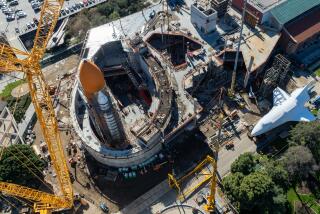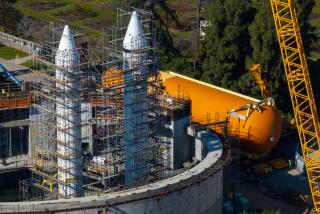Endeavour Astronauts Test Large, Inflatable Antenna
- Share via
KENNEDY SPACE CENTER, Fla. — Shimmering as it swayed in the orbital sunlight Monday 176 miles above Earth, an inflatable antenna swelled to the size of a tennis court and flew alongside space shuttle Endeavour.
“Pretty fantastic,” shuttle commander John Casper said.
The experimental, silver-colored antenna appeared to expand to its full size after being released by the Endeavour astronauts--nearly 50 feet in diameter, supported by three inflatable struts 92 feet long. Depending on your point of view, it looked like a flat parachute or a round trampoline on an upside-down tripod.
After more than an hour’s worth of measurements, the antenna was cut loose from its orbiting platform. The antenna was expected to plunge through the atmosphere and burn up today.
NASA is interested in inflatable antennas, sun shades and other space structures because they are lighter and less expensive than traditional mechanical systems. They also would be more reliable because of fewer moving parts.
Even if punctured by micrometeorites, the thin Mylar foil, similar to that in birthday balloons, would hold its shape because of the low pressure and small amount of gas needed for inflation, officials said.
There were a few surprises: The antenna rotated more than expected, began to tumble and had noticeable rippling across its surface.
Concerned about the tumbling, Mission Control told the astronauts to back away from the antenna a little sooner than planned. The crew had been observing from a distance of 400 feet.
Endeavour’s six-man crew had no problem deploying the antenna, which was folded into a box the size of a kitchen table.
As soon as the doors on the box opened, nitrogen gas began filling the antenna.
The antenna was jettisoned from its platform via tiny explosives that were set off by a timer.
The platform contains all the data from the antenna experiment; the astronauts will pluck it from space today.
“Just remember: Next time you blow up a balloon, you’re using Space Age technology,” Casper said.
More to Read
Sign up for Essential California
The most important California stories and recommendations in your inbox every morning.
You may occasionally receive promotional content from the Los Angeles Times.













